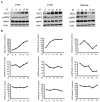Rhythmic expression of DEC2 protein in vitro and in vivo
- PMID: 27284410
- PMCID: PMC4887762
- DOI: 10.3892/br.2016.656
Rhythmic expression of DEC2 protein in vitro and in vivo
Abstract
Basic helix-loop-helix (bHLH) transcription factor DEC2 (bHLHE41/Sharp1) is one of the clock genes that show a circadian rhythm in various tissues. DEC2 regulates differentiation, sleep length, tumor cell invasion and apoptosis. Although studies have been conducted on the rhythmic expression of DEC2 mRNA in various tissues, the precise molecular mechanism of DEC2 expression is poorly understood. In the present study, we examined whether DEC2 protein had a rhythmic expression. Western blot analysis for DEC2 protein revealed a rhythmic expression in mouse liver, lung and muscle and in MCF-7 and U2OS cells. In addition, AMP-activated protein kinase (AMPK) activity (phosphorylation of AMPK) in mouse embryonic fibroblasts (MEFs) exhibited a rhythmic expression under the condition of medium change or glucose-depleted medium. However, the rhythmic expression of DEC2 in MEF gradually decreased in time under these conditions. The medium change affected the levels of DEC2 protein and phosphorylation of AMPK. In addition, the levels of DEC2 protein showed a rhythmic expression in vivo and in MCF-7 and U2OS cells. The results showed that the phosphorylation of AMPK immunoreactivity was strongly detected in the liver and lung of DEC2 knockout mice compared with that of wild-type mice. These results may provide new insights into rhythmic expression and the regulation between DEC2 protein and AMPK activity.
Keywords: DEC2; circadian rhythm; clock gene; phosphorylation of AMP-activated protein kinase.
Figures




Similar articles
-
Tissue-specific disruption of rhythmic expression of Dec1 and Dec2 in clock mutant mice.J Biol Rhythms. 2005 Oct;20(5):404-18. doi: 10.1177/0748730405280195. J Biol Rhythms. 2005. PMID: 16267380
-
DEC1 and DEC2 Crosstalk between Circadian Rhythm and Tumor Progression.J Cancer. 2016 Jan 1;7(2):153-9. doi: 10.7150/jca.13748. eCollection 2016. J Cancer. 2016. PMID: 26819638 Free PMC article. Review.
-
Involvement of c-Myc in the proliferation of MCF-7 human breast cancer cells induced by bHLH transcription factor DEC2.Int J Mol Med. 2015 Mar;35(3):815-20. doi: 10.3892/ijmm.2014.2042. Epub 2014 Dec 17. Int J Mol Med. 2015. PMID: 25524285
-
Anti-apoptotic effect of the basic helix-loop-helix (bHLH) transcription factor DEC2 in human breast cancer cells.Genes Cells. 2010 Apr 1;15(4):315-25. doi: 10.1111/j.1365-2443.2010.01381.x. Epub 2010 Mar 4. Genes Cells. 2010. PMID: 20236182
-
Approach to Functions of BHLHE41/DEC2 in Non-Small Lung Cancer Development.Int J Mol Sci. 2023 Jul 21;24(14):11731. doi: 10.3390/ijms241411731. Int J Mol Sci. 2023. PMID: 37511489 Free PMC article. Review.
Cited by
-
Potential Roles of Dec and Bmal1 Genes in Interconnecting Circadian Clock and Energy Metabolism.Int J Mol Sci. 2018 Mar 8;19(3):781. doi: 10.3390/ijms19030781. Int J Mol Sci. 2018. PMID: 29518061 Free PMC article. Review.
-
BHLHE41 promotes U87 and U251 cell proliferation via ERK/cyclinD1 signaling pathway.Cancer Manag Res. 2019 Aug 14;11:7657-7672. doi: 10.2147/CMAR.S214697. eCollection 2019. Cancer Manag Res. 2019. PMID: 31616182 Free PMC article.
-
Disrupted Ultradian Activity Rhythms and Differential Expression of Several Clock Genes in Interleukin-6-Deficient Mice.Front Neurol. 2017 Mar 22;8:99. doi: 10.3389/fneur.2017.00099. eCollection 2017. Front Neurol. 2017. PMID: 28382017 Free PMC article.
-
BHLHE41, a transcriptional repressor involved in physiological processes and tumor development.Cell Oncol (Dordr). 2025 Feb;48(1):43-66. doi: 10.1007/s13402-024-00973-3. Epub 2024 Sep 10. Cell Oncol (Dordr). 2025. PMID: 39254779 Free PMC article. Review.
-
Circadian Rhythms in the Pathogenesis and Treatment of Fatty Liver Disease.Gastroenterology. 2020 May;158(7):1948-1966.e1. doi: 10.1053/j.gastro.2020.01.050. Epub 2020 Feb 13. Gastroenterology. 2020. PMID: 32061597 Free PMC article. Review.
References
Grants and funding
LinkOut - more resources
Full Text Sources
Other Literature Sources
Molecular Biology Databases
